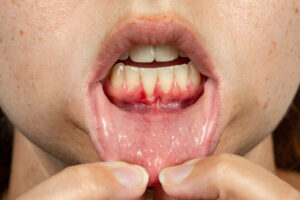Wisdom Tooth Abscess: Causes, Symptoms & Treatment

Key Takeaways
- Understanding: A wisdom tooth abscess is a serious infection caused by trapped bacteria, often around partially erupted or impacted wisdom teeth.
- Symptoms: Look out for severe pain, swelling, fever, bad taste/smell, and difficulty opening your mouth.
- Emergency: Seek immediate dental care, as untreated abscesses can lead to severe complications like the spread of infection throughout the body.
- Treatment: A dentist will drain the abscess, prescribe antibiotics, and potentially perform a root canal or extract the tooth.
- Prevention: Maintain excellent oral hygiene (brushing, flossing, mouthwash) and have regular dental checkups.
- Don’t Delay: Home remedies offer temporary relief, but don’t replace professional treatment. See a dentist promptly if you suspect an abscess.
Table of Contents
What Is an Abscess?
A dental abscess is a pocket of pus that forms in your tooth or gums due to a bacterial infection. There are a few different types:
- Periapical abscess: Forms at the tip of the tooth’s root. Usually caused by severe tooth decay or injury to the tooth.
- Periodontal abscess: Forms in the gums along the side of a tooth root. Often linked to advanced gum disease.
- Gingival abscess: Forms in the gum tissue only and doesn’t involve the tooth or the bone that holds it.
What is an Abscessed Wisdom Tooth?
Wisdom teeth, also known as third molars, are the last teeth to erupt in the mouth, typically appearing in your late teens or early twenties.
Unfortunately, these latecomers can sometimes cause problems, and one of the most concerning is an abscessed wisdom tooth.
An abscess is a collection of pus, a white or yellow substance made up of white blood cells, dead tissue, and bacteria.
It forms as the body’s immune system fights off an infection. In the mouth, an abscess can develop around the tooth root (periapical abscess) or within the gum tissue (periodontal abscess).
Why Wisdom Teeth Are Prone to Abscesses
Wisdom teeth often erupt partially or become impacted, meaning they’re trapped under the gum or bone. This makes them difficult to clean properly, allowing bacteria to build up and potentially lead to infection.
The lack of space in modern human jaws can cause wisdom teeth to grow in at an angle, further increasing the risk of food impaction and infection.
What Are the Symptoms of a Wisdom Tooth Abscess?
- Pain: Severe, throbbing toothache or jaw pain, especially focused around the wisdom tooth. This pain can feel sharp and persistent. Pain might radiate to your ear, neck, or the side of your face where the infection is located. The pain could worsen when lying down.
- Swelling: Swollen, red, and inflamed gums around the wisdom tooth. Swelling might extend to your cheek, jaw, or even down your neck, making your face appear puffy.
- Sensitivity: Increased sensitivity to hot or cold foods and drinks. Even touching the area gently might be extremely painful. Pain when chewing or biting down. The pressure on the tooth can intensify the pain dramatically.
- Bad taste/smell: A foul taste in your mouth due to the pus draining from the abscess. Bad breath (halitosis) that persists even after brushing and flossing.
- Difficulty opening mouth (trismus): Swelling and pain can make it difficult or painful to open your mouth fully.
- Fever and chills: In serious cases, these indicate the infection might be spreading to other parts of your body.
- Swollen lymph nodes: The lymph nodes under your jaw or in your neck might be swollen, tender, and feel like small lumps. This occurs as your immune system fights the infection.
What Should You Do If You Think You May Have a Wisdom Tooth Abscess?
If you think you might have a wisdom tooth abscess, book an appointment with your dentist. Here’s why and what to do:
Why urgent action is necessary
- You need to keep the infection from spreading: An abscessed tooth is a serious infection. If untreated, the infection can spread to your jawbone, other teeth, and even more dangerously to your bloodstream.
- Pain escalation: The pain will likely get much worse over time, making it hard to function normally.
- Serious complications: In rare cases, untreated infections can lead to life-threatening conditions like sepsis.
What you should do:
- Contact a dentist immediately: Explain your symptoms and try to get a same-day appointment as a dental emergency. If you can’t see a dentist that day, go to an urgent care center or emergency room.
- Temporary pain relief: While you wait, you can try: over-the-counter painkillers ( Ibuprofen or acetaminophen), saltwater rinses, cold compresses.
Do not attempt self-treatment: Never try to drain the abscess yourself or use home remedies on a tooth infection. This can make the problem much worse.
What to expect at the dentist
The dentist will examine the tooth and likely take X-rays to confirm an abscess and assess any spread of infection.
Treatment:
- Draining the abscess: The dentist might make an incision to drain the pus.
- Antibiotics: You’ll likely be prescribed antibiotics to kill the infection.
- Root canal: If the tooth can be saved, you might need a root canal treatment.
- Tooth extraction: If the tooth is severely damaged, extraction might be the only way to resolve the issue.
Wisdom Tooth Abscess Stages
While there aren’t strictly defined medical stages of a wisdom tooth abscess, it’s useful to think of its progression to understand why prompt treatment is important.
Here’s a breakdown of how it typically develops:
1. Enamel Decay
Bacteria in your mouth begin to break down the outer layer of the tooth (enamel), especially in hard-to-reach areas where wisdom teeth often reside.
Symptoms: Might have no symptoms, or you could experience increased tooth sensitivity. You might notice white spots on the tooth.
2. Dentin Decay
The decay has progressed through the enamel and into the dentin, the softer layer beneath.
Symptoms: Likely sensitivity to hot, cold, or sweet foods. You may see a visible cavity (hole) in the tooth.
3. Pulp Infection
The bacteria reach the inner pulp of the tooth, which contains nerves and blood vessels. This infection creates inflammation and is where significant pain usually begins.
Symptoms: Intense, throbbing pain in the tooth and jaw. The pain might radiate to your ear, neck, etc. Swelling might occur in the face.
4. Abscess Formation
Your body fights the infection by sending white blood cells to the area. The resulting buildup of pus and dead tissue is an abscess.
Symptoms: Severe pain, swollen face, fever, a pus-filled bump (like a pimple) near the tooth, bad breath or foul taste in the mouth.
5. Spread of Infection
If still untreated, an abscess can lead to complications:
- The infection can spread to the jawbone, nearby teeth, or even the bloodstream (which becomes very dangerous).
- A fistula (small tunnel) might form, allowing pus to drain out through your gum or skin.
- In rare, extreme cases, severe complications like sepsis can occur.
Symptoms: Worsening symptoms from the earlier stages, with the possibility of high fever, chills, nausea, and difficulty opening your mouth.
Treatment of Wisdom Teeth-Related Abscesses
The treatment of wisdom tooth-related abscesses focuses on two main goals:
Management of the Immediate Infection
- Drainage: If an abscess is present, the dentist’s first step is often to drain the pus. This involves making a small incision to allow the pus to escape, providing relief from pressure and pain. They will then clean the area with a saline solution.
- Antibiotics: You’ll likely be prescribed a course of antibiotics to fully eliminate the bacterial infection. These are essential even if the abscess has been drained.
Addressing the Underlying Cause (Wisdom Tooth)
Once the infection is under control, these options are considered to prevent recurrence:
- Root Canal Treatment: If the tooth is salvageable, the dentist might perform a root canal to clean out the infected inner pulp chamber and preserve the structure of the tooth.
- Wisdom Tooth Extraction: The most common solution, especially with impacted or problematic wisdom teeth, is simple removal. If the tooth cannot be saved, this eliminates the source of the issue and prevents future infections in that area.
- Pain Management: During treatment, your dentist will provide local anesthetic for procedures and recommend over-the-counter painkillers to manage discomfort.
- Follow-up Care: You’ll need to follow your dentist’s instructions for wound care, completing your antibiotics, and potentially scheduling a follow-up appointment to monitor healing.
Home Remedies for Dental Abscess
Please understand that there are NO true home remedies that can cure a dental abscess. A dental abscess is considered a dental emergency that requires dental treatment.
Still, some home remedies may offer temporary symptom relief while you wait for your appointment:
Pain and Swelling Management
- Saltwater Rinse: Dissolve 1/2 teaspoon of salt in a glass of warm water. Swish it around your mouth for 2-3 minutes, focusing on the affected area before spitting it out. Saltwater has mild antiseptic properties and can help reduce inflammation.
- Cold Compress: Apply a cold compress to the outside of your cheek for 15-20 minutes at a time to reduce swelling and pain.
- Over-the-counter Pain Relief: Ibuprofen or acetaminophen can help manage pain and discomfort.
- Clove Oil: Clove oil possesses a natural numbing agent called eugenol. Dilute a few drops in a carrier oil like olive oil and apply it to the affected area with a cotton swab.
Other At-Home Options
- Hydrogen Peroxide Rinse: Create a solution of equal parts 3% hydrogen peroxide and water.Swish gently for a few minutes and spit out. Hydrogen peroxide has antiseptic properties, but use it with caution and avoid swallowing.
- Garlic: Crush a fresh garlic clove and mix it with a bit of salt to make a paste. Apply this directly to the affected area. Garlic has some antibacterial properties. However, be mindful it can be strong and potentially irritate your gums.
Preventing The Development Of A Dental Abscess
Preventing dental abscesses is all about maintaining excellent oral hygiene and having regular dental checkups. Here’s a breakdown of the most important practices:
Meticulous Oral Hygiene
- Brushing: Brush your teeth twice a day for at least two minutes each time. Use a fluoride toothpaste and a soft-bristled brush to clean all surfaces of your teeth effectively.
- Flossing: Floss at least once a day to remove food debris and plaque from between your teeth, where your toothbrush can’t reach.
- Mouthwash (optional): Antiseptic mouthwash can help reduce bacteria in your mouth, but it’s not a substitute for brushing and flossing.
Healthy Diet
- Limit sugary and starchy foods: These feed the bacteria in your mouth and contribute to tooth decay. Opt for fruits, vegetables, and whole grains instead.
- Stay hydrated: Drinking plenty of water helps rinse away food particles and neutralize acids in your mouth.
Regular Dental Checkups:
- Cleanings and exams: Visit your dentist every six months (or as recommended) for professional cleanings and checkups. They can spot developing decay or other problems early, before they turn into abscesses.
Additional Tips
- Protect your teeth: If you play contact sports, wear a mouthguard to protect your teeth from injury.
- Manage dry mouth: Saliva helps protect against bacteria. If you have dry mouth, talk to your dentist about ways to manage it.
- Address dental problems promptly: Don’t ignore toothaches, sensitivity, or other issues. Addressing them early is key to preventing complications and infections. Read more: Can You Get Your Wisdom Teeth Removed While Pregnant
The Dangers of Untreated Abscesses
An untreated abscess, whether from a wisdom tooth or any other tooth, poses significant dangers for your health. The biggest risk is that the infection will worsen and spread beyond the initial tooth.
This can damage your jawbone, infect nearby teeth, or even invade your sinuses. The pain and swelling associated with the abscess will likely intensify, making daily life difficult.
In more serious cases, an untreated abscess can lead to a condition called Ludwig’s Angina, characterized by a fast-spreading infection in the floor of the mouth that can hinder breathing and swallowing.
Even worse, bacteria from the abscess can enter your bloodstream, a potentially life-threatening condition called sepsis. Though rare, the infection can spread to the brain, causing serious neurological problems.
Besides the immediate health dangers, an untreated abscess can result in tooth loss and permanent damage. The infection can destroy nerves, bone, and other structures in your jaw, potentially causing long-term chronic pain and difficulty eating.
That’s why you should prevent the infection from spreading. Seek dental care as soon as you suspect a dental abscess to prevent these serious complications.
Read more: Infected Gum after Wisdom Tooth Removal
FAQ on Wisdom Tooth Abscess
Can a wisdom tooth abscess go away on its own?
Unfortunately, a wisdom tooth abscess will not go away on its own. The abscess is a pocket of pus caused by bacterial infection. Without treatment, the infection will continue to worsen, potentially leading to serious complications. While a small abscess might temporarily rupture and drain, providing some relief, the underlying infection will remain and likely come back stronger.
How do you tell if you have an abscessed wisdom tooth?
The common signs of an abscessed wisdom tooth are intense pain (sometimes radiating to your jaw or ear), swelling in the surrounding gums or face, redness, a bad taste or smell in your mouth, difficulty opening your mouth, and possibly a fever. If you experience these, see a dentist immediately.
Is a wisdom tooth abscess an emergency?
Yes, a wisdom tooth abscess is considered a dental emergency. The infection can spread quickly, causing severe pain and potentially leading to serious complications like spreading infection or even sepsis. Seek immediate care from a dentist or an urgent care/ER if you can’t see your dentist right away. Read more: How Long Until a Tooth Infection Kills You?
How do you get rid of an abscess on your wisdom teeth?
Unfortunately, you can’t get rid of a wisdom tooth abscess on your own. To eliminate the infection and prevent complications, you’ll need to see a dentist. They may drain the abscess, prescribe antibiotics, and ultimately, the wisdom tooth will likely need a root canal or extraction. If you get it removed, here is some additional information on how soon can you talk after wisdom teeth removal
How long does wisdom tooth abscess last?
The duration of a wisdom tooth abscess depends entirely on whether or not you get treatment. A minor, localized infection treated quickly with antibiotics might clear up in a week or so. Without treatment, the infection will worsen, leading to severe pain and the potential for serious health complications. In severe cases, the healing process after extraction and treatment of the infection can take weeks or even months.
Do I Need My Wisdom Teeth?
Most people don’t actually need their wisdom teeth. They’re a leftover from our ancestors who needed extra molars to chew tough foods. Modern jaws are often too small to comfortably accommodate wisdom teeth, and they aren’t necessary for proper chewing function.
What’s an Impacted Wisdom Tooth?
An impacted wisdom tooth is a wisdom tooth that hasn’t fully erupted through the gums. This can happen because there isn’t enough space in the jaw, or the tooth is growing at an awkward angle, causing it to become trapped beneath the gumline or pushing against other teeth.
Can a Wisdom Tooth Cause an Abscess?
Yes, a wisdom tooth can absolutely cause an abscess. Impacted or partially erupted wisdom teeth are especially prone to trapping food and bacteria, which can lead to infection. If this infection reaches the inner tooth pulp or forms between the tooth and gum, a painful abscess can develop.
Sources:
- Impacted wisdom teeth: https://www.mayoclinic.org/diseases-conditions/wisdom-teeth/symptoms-causes/syc-20373808
- “Dental Abscess: A Review” from the Journal of International Society of Preventive & Community Dentistry on PubMed Central (PMC): https://www.ncbi.nlm.nih.gov/pmc/articles/PMC4455701/
Fact Checked
Our dedicated team rigorously evaluates every article and guide to ensure the information is factual, up-to-date, and free of bias.
Updated Regularly
We update our articles and reviews regularly to ensure you have access to the latest data in the dental industry.
The content on Dental3DU’s blog is intended for educational purposes only. This information should not be relied upon as professional medical counsel. Be sure to always consult with your dentist about the dangers and benefits of any medication, treatment or procedure.







